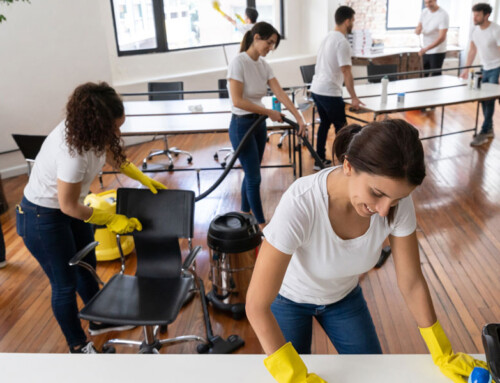Want a Guaranteed Profit Increase?
Henry Ford said, “Nothing is particularly hard if you divide it into small jobs.” This is so true when trying to find additional profit from client accounts (if you are a building service contractor) or money in a facility’s cleaning and maintenance budget (if you are an in-house facility manager).
Both contractors and facility managers should be able to wrangle up more money in the budget by properly maintaining a building’s assets. Not only does long-term planning protect the lifespan of a facility’s assets—such as carpet and flooring—but spending money to clean and upkeep these items on a regular basis can help to save money in the long run.
According to the Carpet and Rug Institute (CRI), “Carpet is an excellent item to discuss, because it is so straightforward to accomplish extending the useful life of this type of flooring.” Below are steps on how to properly maintain and extend the life of your carpet, and how a long-term carpet care maintenance program can help your organization’s budget over time.
Creating a Long-Term Plan
According to CRI, a customized comprehensive carpet care program consists of five elements:
- Soil containment: This involves stopping soil from entering the facility by placing mats at building entrances. “Professionals and organizations throughout the industry seem to agree that mats can trap somewhere between 80 to 90 percent of the soil that is tracked into a building. A rule of thumb is to make sure at least 15 feet of matting is present at all entrances, exits, service ways, and side doors of a building.”
“It’s a good idea to invest in extra walk-off mats,” said Pat Jennings, director of standards and specifications at CRI, in a 2015 Cleaning and Maintenance Management article on winter carpet care. “But be sure to clean them, because it doesn’t do carpet any good for people to wipe their feet off on dirty mats and then track the soil and moisture onto the carpet.”
- Vacuuming: Regular removal of dry soil with a CRI-approved vacuum that is well maintained is vital to extending the life of your carpet.
- Removing spots and spills: There are five types of stains: protein-based, oil based, tannin, dye, and a combination of these stains. Do not treat a spot with any type of product until you can figure out what type of spot you are cleaning. In this case, not taking action is actually better than going forward with the wrong action. Buy a professional kit that tests what type of stain you are trying to remove before trying to resolve it.
- Interim cleaning: This is a step above vacuuming, but not as comprehensive as deep cleaning. According to Paul Tucker, communications coordinator for CRI, interim maintenance “acts as a stopgap between these two types of maintenance to restore carpet’s appearance by removing dirt that damages the carpet’s fibers. … There is not a single type of machine specifically meant for interim maintenance; however, rotary brushing, bonnet, and dry compound systems are just a few examples of interim cleaning systems.” This type of cleaning can involve all traffic areas or a touchup of highly walked on areas in the building.
- Restorative cleaning: This step involves “scheduled frequency deep cleaning to remove residues and trapped soils.” It has been rightly said that carpet is like the garbage can for the building, due to buildup of soils over time; thus restorative cleaning is essential to reach the useful life provided by the carpet’s manufacturer. Most recommend steam cleaning, but be sure to read the warranty that comes with your carpet, and if in doubt, call the manufacturer to verify what type of carpet cleaning it recommends.
Profits and Proper Vacuum Care
It was not many years ago that vacuums were heavy, and custodians could get more dirt cleaning out the cloth bag than they had accumulated using the vacuum in the first place. If you purchase and take care of a good vacuum, you can extend its life by five years, which in the long term, can save your organization money. This is especially true if your staff takes loving care of each vacuum.
The following tips from, “How to Extend the Life of Your Vacuum Cleaner,” an article by Jean Hanson published at www.thejanitorialstore.com, outline the process for extending each vacuums’ lifespan.
- Empty or change the bags, even if they are only half full. Make it a habit to clean or change the bag at the end of each day.
- Maintain filters/beater bars/brushes/belts/cords.
- Clean beater bars daily.
- Clean filters weekly.
- Replace brushes when they reach half their normal length.
- Check belts for cuts and wear, and replace them as needed.
- Check cords for cuts and properly remove them from sockets.
- Train staff on proper vacuum use. This will help to keep vacuums running longer. For example, remember to tell them large items, such as cigarette butts, paper clips, and pieces of food can damage the appliance. Vacuuming over wet areas can also corrode and deteriorate the vacuum’s internal parts.
Return on Investment
The return on investment in savings and increased reliability from a proactive rather than reactive approach to carpet care and asset management has been proven time and time again. This type of program will increase your profits and keep your equipment running efficiently, thereby reducing unnecessary utilities and costs.
The time and money spent on preventive and predictive maintenance is a key indicator of “pay now or pay later.” John F. Kennedy said it best: “There are risks and costs to a program of action; but they are far less than the long-range risks and costs of comfortable inaction.”
An Asset Management Tool You Can UseTools such as ISSA’s Value of Clean Calculator can help organizations choose flooring for each type of facility area and create a program that will extend the useful life of each type of floor. Learn more at www.issa.com/valuecalc.


















